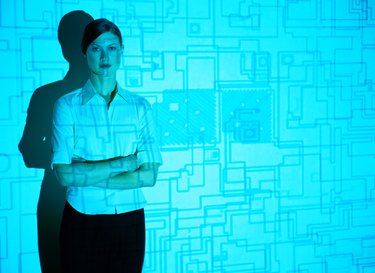
Most digital projectors display multimedia content fed to them from a laptop or desktop computer. Including the host system, the required cables or wireless connection, and the projector itself, the result becomes a large, luggable collection of technology. If you prefer a projection method with no computer required, you can reach back to the past for tried-and-true alternatives or forward to new digital alternatives.
Slide
Video of the Day
The slide projector gave birth to the modern multimedia presentation, down to the use of the word "slide" to refer to an individual page in a digital presentation document. Although slide shows may seem low-tech compared to today's computer-connected projectors, they require no data files, host computers or cables, and neither crash nor require rebooting. A bright light source shines through the transparent film base of the slide and into a chain of optical hardware that culminates in a lens. Displayed on a screen -- a permanent or portable optical-quality sheet covered in tiny glass beads -- the projector's output maintains autofocus and can proceed automatically through an entire carousel of slides.
Video of the Day
Overhead
The overhead projector also works with transmissive -- transparent -- media. Instead of working its way through a container of slides, it provides a stable glass base on which to set sheets of plastic, printed or hand-written with the text and graphics of your message. Sized for use in desktop printers or office copiers, these transparent sheets can carry information printed from any program on your computer, including your presentation software itself. Because you can write on overhead transparencies with erasable wax pencils, you can use them interactively, adding comments as you talk to your audience. Overhead projectors rely on a system of mirrors and lenses to display your information on a projection screen.
Opaque
Opaque projectors gain their name from the type of material they present: opaque media, including books and printed pages from your laser or inkjet printer; and artwork, including photographs, paintings, drawings, fiber art and folk artifacts. Artists use opaque projectors to translate a small drawing into the basis for a wall-filling mural or the scenery components for a stage production. Because all the media they project consist of reflective objects, opaque projectors provide an ideal way to share the contents of a bound volume without destroying it.
Laser
Pico laser projectors -- also called mini beamers or mobile projectors -- enable you to share digital files without using your computer as their source. At a pound or less in weight, these pocket-sized devices can project video or photographs directly from a digital camera, smartphone or tablet device, or using their built-in playback capabilities, and require neither conventional lamp nor lens. Although you can connect these projectors to a computer, they function equally well without a digital host, enabling them to accommodate the travel needs of business professionals who prefer not to lug a bulky, heavy digital projector.
- Old Photo: Bell and Howell 35mm Slide Cube Projector
- Affordable Slide Scanning: 35mm Slide Projectors
- Northeastern Illinois University Chicago: Instructional Design in Human Resource Development: Overhead Projector
- AudioLinks Services: 4 Projector Technologies: Overhead, Opaque, LCD & DLP Projectors
- Art Is Fun: How to Use an Art Projector
- Art Supplies: Art Projectors
- Projector Central: The Evolution of Projection Technology
- ProjectorReviews.com: The 2010 Pico Projector and Pocket Projector Guide and Reviews
- AAXA Technologies: AAXA L1 Laser Pico Projector
- Scanned Laser Pico-Projectors: Seeing the Big Picture (With a Small Device)
- ProjectorReviews.com: AAXA Pico -- Review Summary